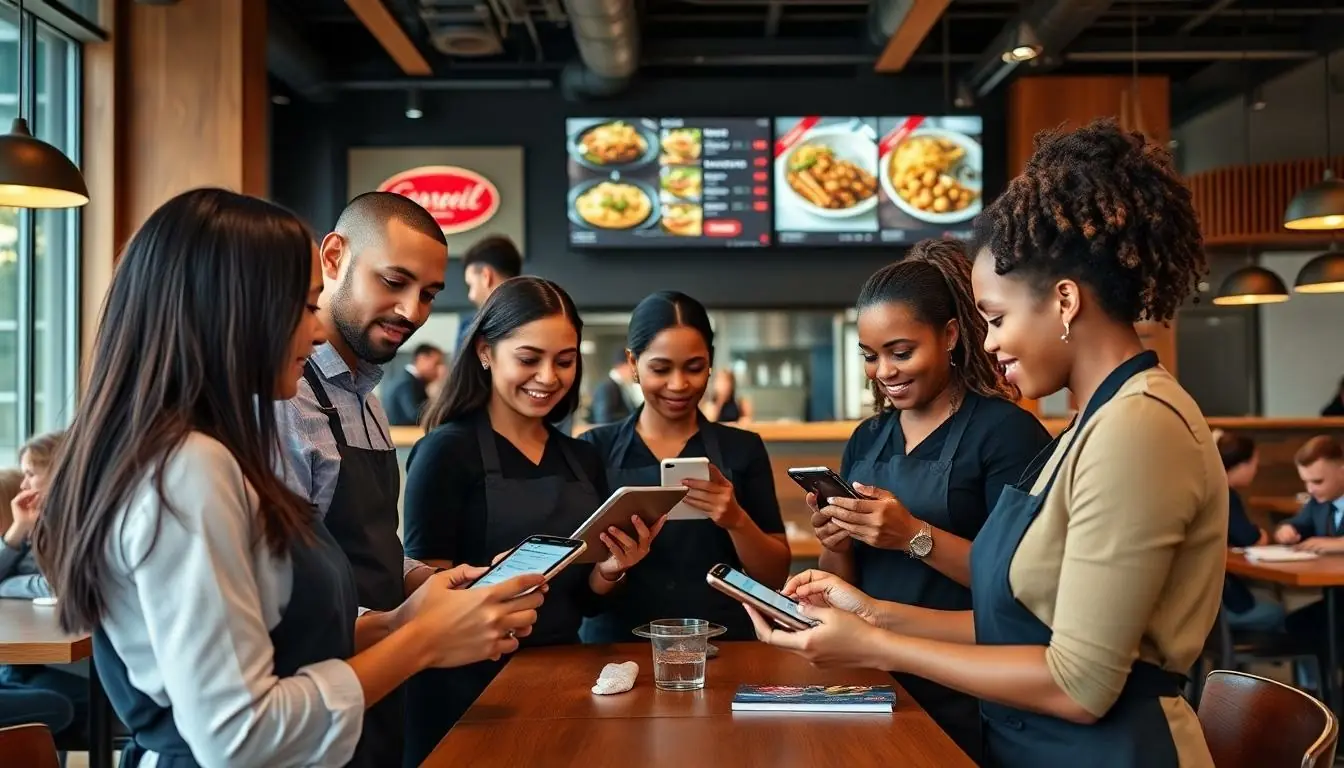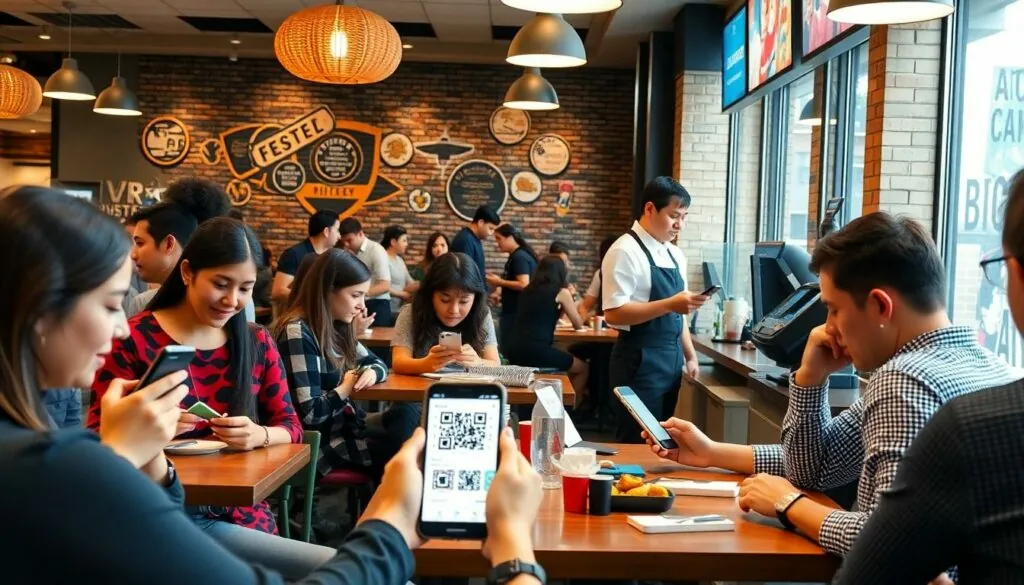In a world where waiting in line feels like waiting for a pot of water to boil, digital ordering has swooped in like a superhero in a cape. Restaurants are embracing this trend faster than a chef can flip a pancake, transforming the way diners place their orders. With just a few taps on a screen, patrons can summon their favorite meals without the hassle of human interaction—perfect for those who believe small talk should be reserved for the dinner table.
As technology evolves, so do the expectations of hungry customers. They want speed, convenience, and a sprinkle of personalization, all served up on a digital platter. From mobile apps to voice-activated orders, the landscape is changing, and restaurants that adapt will thrive. Buckle up as we dive into the latest digital ordering trends that are reshaping the culinary scene, one click at a time.
Table of Contents
ToggleOverview of Digital Ordering Trends for Restaurants
Digital ordering continues to reshape the restaurant industry, driven by evolving customer expectations. Customers increasingly prefer options that enhance convenience. Many diners appreciate mobile apps that allow quick order placement without wait times. Voice-activated technology has also gained traction, enabling users to order simply by speaking.
Data shows that 60% of restaurant customers opt for digital orders to save time. This shift promotes efficiency and meets the demand for fast service. Contactless payments and digital loyalty programs contribute to this trend, incentivizing repeat visits. Restaurants adopting these features report higher customer satisfaction rates.
Restaurants have begun to leverage AI to personalize customer experiences. They analyze past orders to suggest tailored menu choices, enhancing the likelihood of upselling. Moreover, social media integration enables customers to order directly from platforms like Instagram, further streamlining the process.
Delivery apps remain vital for many restaurants, creating a competitive landscape. Partnerships with third-party services help restaurants reach a broader audience while managing order logistics. Current statistics indicate that more than 70% of consumers use these apps regularly.
Adoption of QR codes for menus simplifies the ordering process. Customers scan codes to view menus and place orders directly from their devices. This approach minimizes contact and aligns with ongoing health considerations.
The digital ordering landscape is rapidly evolving, emphasizing speed, convenience, and personalization. As technology progresses, restaurants that embrace these trends stand to gain a significant competitive advantage.
Key Technologies Driving Change

Digital ordering technology transforms how restaurants operate, enhancing customer experience and streamlining service delivery.
Online Ordering Solutions
Online ordering solutions offer restaurants the tools needed to meet consumer demand for convenience. More than 60% of restaurant customers prefer placing orders digitally to save time. These platforms enable seamless transactions and integration with kitchen management systems, optimizing order fulfillment. Robust analytics features allow restaurants to track customer preferences and sales trends. As a result, those utilizing these solutions can increase efficiency and improve customer satisfaction.
Mobile Apps and QR Codes
Mobile apps and QR codes significantly modernize the dining experience. Restaurants leverage mobile applications to facilitate easy ordering, enabling diners to customize meals from their devices. QR codes streamline menu access, allowing customers to view offerings without physical menus. This contactless approach adheres to health guidelines and enhances safety. Additionally, 70% of consumers regularly use delivery apps, emphasizing the importance of these technologies in reaching customers effectively. Implementing both mobile apps and QR codes drives engagement and fosters loyalty among patrons.
Customer Preferences and Behavior
Understanding customer preferences and behavior is crucial for restaurants navigating the digital ordering landscape. The focus on convenience and personalization defines current trends.
Impact of Convenience
Convenience drives customer choices in dining. Data shows that 60% of restaurant customers opt for digital orders to save time. Speedy service enhances the overall experience, making quick transactions a priority for diners. With the rise of seamless payment methods and contactless options, customers enjoy ordering without long waits. Restaurants using QR codes for easy access to menus respond to this need effectively. Convenience becomes essential as more diners choose digital channels over traditional methods.
Demand for Personalization
Personalization shapes customer interactions in the digital ordering sphere. Over 70% of consumers express interest in tailored recommendations based on previous orders. AI technology analyzes customer behavior, enabling restaurants to offer personalized menu suggestions. Patrons appreciate when their favorite choices appear during the ordering process. Integration with social media platforms allows for targeted promotions that resonate with individual visitors. By focusing on personalized experiences, restaurants foster loyalty and encourage repeat business.
Integration with Restaurant Operations
Digital ordering trends necessitate robust integration with restaurant operations. Streamlined processes enhance overall efficiency and customer satisfaction.
Managing Inventory and Delivery
Real-time inventory management systems connect directly to digital ordering platforms. Such integration ensures accurate stock levels, preventing over-ordering or stock-outs. Data shows that 60% of customers prefer quick service, emphasizing the need for timely deliveries. Enhanced logistics solutions support restaurants in maintaining optimal delivery times while minimizing costs. Over 70% of consumers rely on delivery apps, underscoring the importance of seamless coordination between inventory and delivery operations. Automation tools further assist in tracking orders, enabling proactive management of supply chains.
Enhancing Customer Experience
Personalized experiences significantly impact customer loyalty. Advanced digital ordering systems recommend menu items based on previous purchases, aligning with over 70% of consumers who seek tailored suggestions. Mobile applications facilitate easy access to menus, promoting contactless interactions that meet health guidelines. Integration with loyalty programs encourages repeat visits by rewarding customers for their choices. Features like user-friendly interfaces and quick re-ordering options cater to the growing demand for convenience. Restaurants that prioritize these enhancements foster positive dining experiences, driving customer satisfaction and retention.
Challenges Faced by Restaurants
Restaurants encounter several challenges when integrating digital ordering systems into their operations. These hurdles can impede the efficient adoption of new technology and impact customer satisfaction.
Technical Limitations
Technical limitations frequently hinder restaurants from fully utilizing digital ordering platforms. Inadequate internet connectivity often leads to latency issues, frustrating both staff and customers. Many restaurants struggle with outdated hardware, preventing them from leveraging advanced features in digital ordering systems. Integration complexities with existing point-of-sale systems can create data inconsistencies, making inventory management challenging. More than 60% of restaurant managers report that technical difficulties negatively affect operational efficiency. These technical barriers necessitate ongoing training and investment, which can strain resources and increase operational costs.
Competition and Market Saturation
Competition in the restaurant industry grows as digital ordering trends evolve. Market saturation leads to an influx of new players offering similar services, making it essential for established restaurants to stand out. Over 70% of consumers regularly use delivery apps, intensifying competition among restaurants. Differentiation through unique menu options or loyalty programs becomes critical for attracting and retaining customers. Restaurants that can’t adapt to these competitive pressures risk losing market share to more agile newcomers. Staying relevant requires continuous innovation and responsiveness to consumer preferences, which can challenge smaller establishments with limited resources.
The digital ordering landscape is transforming the restaurant industry by prioritizing speed and convenience. As customers increasingly demand personalized experiences and seamless interactions, restaurants must adapt to these evolving preferences. Embracing technology like AI and mobile apps not only enhances efficiency but also fosters customer loyalty.
While challenges exist in integrating these systems, the benefits far outweigh the hurdles. Restaurants that stay ahead of the curve by investing in robust digital solutions and innovative strategies will likely thrive in this competitive environment. By focusing on customer satisfaction and operational efficiency, they can secure a strong position in the marketplace and meet the growing expectations of today’s diners.





